
Le Sony'r Ra, better known as Sun Ra, was an American jazz composer, bandleader, piano and synthesizer player, and poet known for his experimental music, "cosmic" philosophy, prolific output, and theatrical performances. For much of his career, Ra led The Arkestra, an ensemble with an ever-changing name and flexible line-up.
Free jazz, or free form in the early to mid-1970s, is a style of avant-garde jazz or an experimental approach to jazz improvisation that developed in the late 1950s and early 1960s, when musicians attempted to change or break down jazz conventions, such as regular tempos, tones, and chord changes. Musicians during this period believed that the bebop and modal jazz that had been played before them was too limiting, and became preoccupied with creating something new. The term "free jazz" was drawn from the 1960 Ornette Coleman recording Free Jazz: A Collective Improvisation. Europeans tend to favor the term "free improvisation". Others have used "modern jazz", "creative music", and "art music".
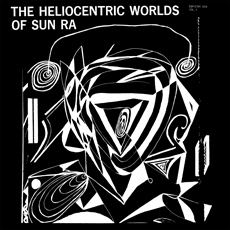
The Heliocentric Worlds of Sun Ra, Volume One is a 1965 album by the jazz musician Sun Ra. The back cover describes it as an "album of compositions and arrangements by Sun Ra played by Sun Ra and his Solar Arkestra".
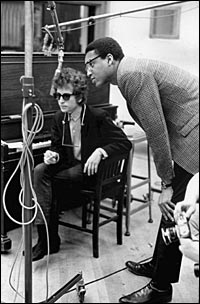
Thomas Blanchard Wilson Jr. was an American record producer. He is best known for his work in the 1960s with acclaimed artists such as Bob Dylan, Frank Zappa and the Mothers of Invention, Simon & Garfunkel, the Velvet Underground, Cecil Taylor, Sun Ra, Eddie Harris, Nico, Eric Burdon and the Animals, the Blues Project, the Clancy Brothers and Tommy Makem, and others.
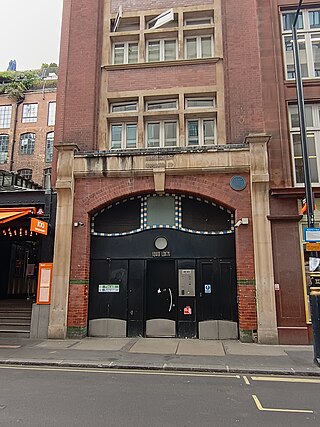
The Marquee Club was a music venue in London, England, which opened in 1958 with a range of jazz and skiffle acts. It was a small and relatively cheap club, in the heart of London's West End.

Sweetwater Saloon was a bar and music venue located at 153 Throckmorton Avenue Mill Valley, California, with a 30-year history of live musical performances by the likes of Bonnie Raitt, Elvis Costello, Jerry Garcia, The String Cheese Incident, John Lee Hooker and Carlos Santana. There were typically at least 4 to 5 musical acts booked per week making it a popular local hangout. Sweetwater Saloon also featured an open mike night on Mondays that occasionally featured surprise performances by well-known artists such as Gregg Allman, Train and others. Village Music, a nationally recognized independent record store also in Mill Valley held twice-yearly parties at Sweetwater by well-known musicians who were also Village Music store customers. A documentary film about Village Music, Sweetwater and the music community in Mill Valley,Village Music: Last of the Great Record Stores was released in 2012. After closing in 2007 it was reopened as Sweetwater Music Hall in 2012 by Bob Weir and his partners a few blocks away from its original location
The Half Note was a jazz club in New York City, New York that flourished in two Manhattan locations – from 1957 to 1972 in SoHo at 289 Hudson Street at Spring Street and from 1972 to 1974 in Midtown at 149 West 54th Street, one block west of the Museum of Modern Art.
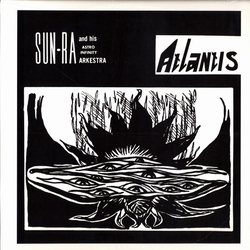
Atlantis is an album by American jazz musician Sun Ra and his Astro-Infinity Arkestra, released in 1969 by El Saturn Records.

Featuring Pharoah Sanders and Black Harold is a jazz album by Sun Ra, recorded live on December 31, 1964, but not released until 1976, on Ra and Alton Abraham's El Saturn label. An expanded version of the album was reissued in 2009 by ESP-Disk, and again in 2017 by Superior Viaduct. A complete version of Sun Ra's performances on December 30 and 31, 1964 were released in 2012 on the Pharoah Sanders album In The Beginning 1963-1964.
Salah Ragab was an Egyptian drummer.

Interstellar Low Ways is an album recorded by the American jazz musician Sun Ra and his Myth Science Arkestra, mostly recorded in Chicago, 1960, and released in 1967 on his own El Saturn label. Originally titled Rocket Number Nine, the album had acquired its present name, and the red-on-white sleeve by Claude Dangerfield, by 1969. The album is known particularly for the two songs featuring chants, "Interplanetary Music" and "Rocket Number Nine Take off for the Planet Venus". These would stay in the Arkestra's repertoire for many years.
Rocket Number Nine points toward the music that the Arkestra would be playing on the lower East Side of New York City. The tenor sax solo isn't the work of John Coltrane in 1962, but of John Gilmore in 1960. And not even Ornette Coleman's bassists were playing like Ronnie Boykins at this date.
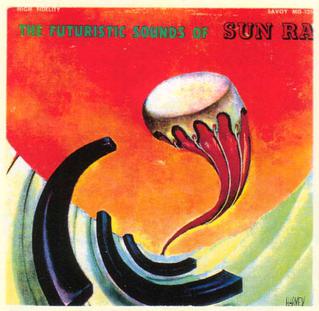
The Futuristic Sounds of Sun Ra is an album by the American jazz musician Sun Ra and his Arkestra, recorded on October 10, 1961, for the Savoy label and released in 1962.

Bad and Beautiful is an album by the American jazz musician Sun Ra and his Arkestra. Recorded in 1961 in New York City at the Choreographers' Workshop, 414 W. 51st St., the album was the second to be recorded in New York by the Arkestra after leaving Chicago, but would remain unreleased until 1972. The album is considered to represent an important transition between the big band approach of the Chicago recordings, and the more 'outside' approach of Ra's smaller bands recorded later in the decade:
'Aside from "Exotic Two," the tunes are split between standards and blues originals, but there are indications of the direction the Arkestra would take throughout the '60s. "Search Light Blues" has some interesting percussion accents finding their way into the arrangement, and "Exotic Two" alludes more clearly to the percussion-heavy sound that dominated many of the '60s recordings. Sun Ra plays piano exclusively on this recording, and Gilmore gets lots of room to shine. A significant transitional LP, this is probably the last "inside" record the Arkestra would record as they forged new sonic paths into the mid-'60s.' Sean Westergaard, All Music Guide link

Art Forms of Dimensions Tomorrow is an album by the American jazz musician Sun Ra and his Solar Arkestra. Often considered the first of Ra's 'outside' recordings, the album was the first to make extensive use of a discovery by the Arkestra's drummer and engineer Tommy Hunter:
'Art Forms of Dimensions Tomorrow.... contained "Cluster of Galaxies" and "Solar Drums", two rhythm section exercises with the sound treated with such strange reverberations that they threatened to obliterate the instruments' identity and turn the music into low-budget musique concrète. While testing the tape recorder when the musicians were tuning up one day, Hunter had discovered that if he recorded with the earphones on, he could run a cable from the output jack back into the input on the recorder and produce massive reverberation:
"I wasn't sure what Sun Ra would think of it... I thought he might be mad - but he loved it. It blew his mind! By working the volume of the output on the playback I could control the effect, make it fast or slow, drop it out, or whatever." [Tommy Hunter]
'By the 1950s commercial recording companies had developed a classical style of recording which assured that the recording process itself would be invisible... but Sun Ra began to regularly violate this convention on the Saturn releases by recording live at strange sites, by using feedback, distortion, high delay or reverb, unusual microphone placement, abrupt fades or edits, and any number of other effects or noises which called attention to the recording process. On some recordings you could hear a phone ringing, or someone walking near the microphone. It was a rough style of production, an antistyle, a self-reflexive approach which anticipates both free jazz recording conventions and punk production to come.' John F Szwed

Cosmic Tones for Mental Therapy is an album by the American Jazz musician Sun Ra and his Myth Science Arkestra recorded in 1963, but not released until 1967 on Sun Ra's own Saturn label. The record was reissued on compact disc by Evidence in 2000.

Other Planes of There is an album by the American Jazz musician Sun Ra and his Solar Arkestra. Recorded in 1964, the album had been released by 1966 on Sun Ra's own Saturn label. The record was reissued on compact disc by Evidence in 1992.
'Granted, the selection is certainly not as abrasive and demanding as later efforts, although there is strident involvement from everyone within the dense arrangement. The brass and reed sections provide emphasis behind an off-kilter and loping waltz backdrop. All the more impressive is how well the material has held up over the decades. Even to seasoned ears, the music is pungent and uninhibited, making Other Planes of There a highly recommended collection.' Lindsay Planer

John F. Szwed is the John M. Musser Professor Emeritus of Anthropology, African American Studies and Film Studies at Yale University and an Adjunct Senior Research Scholar in the Center for Jazz Studies at Columbia University, where he previously served as the Center's Director and Professor of Music and Jazz Studies. Szwed is the author of many books on jazz and American music, including studies of Sun Ra, Miles Davis, Jelly Roll Morton, Alan Lomax, Billie Holiday and Harry Everett Smith.

Thunder of the Gods is an album by Sun Ra and His Arkestra featuring unreleased live and studio recordings which was issued in April 2017 on the Modern Harmonic label.

Live at Slug's Saloon is a live album by the American jazz saxophonist Albert Ayler recorded on May 1, 1966 at Slugs' Saloon in New York City. The music was originally released in 1982 as Albert Ayler Quintet Live at Slug's Saloon volumes 1 and 2 on Base Records (Italy), DIW Records (Japan), and ESP-Disk (U.S.), and, over the years, was reissued by a variety of small labels under different titles. A CD containing both volumes, plus an additional track recorded at the same concert, was released by ESP-Disk with the title Slugs' Saloon. On the album, Ayler plays tenor saxophone, and is accompanied by his brother Donald Ayler on trumpet, Michel Samson on violin, Lewis Worrell on bass, and Ronald Shannon Jackson on drums.

Gilly's was a 250-seat music venue in Dayton, Ohio, mainly hosting jazz and blues music, which opened in July 1972 and closed on New Years' morning in January 2018.

















